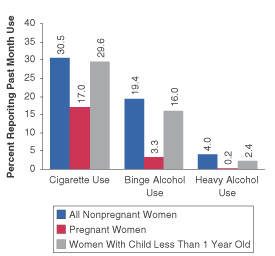Given the potential harmful effects of tobacco and alcohol to human embryos and fetuses, substantial public health attention has been directed toward tobacco and alcohol use among pregnant women.1, 2 The 1999 National Household Survey on Drug Abuse (NHSDA) contains data on the current use (i.e., use in the month prior to the survey) of tobacco and alcohol among pregnant women aged 15 to 44.3
Prevalence of Use Among Pregnant Women4
Among women aged 15 to 44 who were currently pregnant, about 17 percent reported the use of one or more tobacco products (cigarettes, smokeless tobacco, cigars, or pipes) in the past month (Table 1). Cigarettes were the most widely used tobacco product, with an estimated 416,000 pregnant women smoking cigarettes in the past month. The rate of past month cigarette smoking among pregnant women (17 percent) was about half the level of nonpregnant women (31 percent).
About 13 percent of pregnant women reported drinking alcohol in the past month, with 3 percent reporting "binge" alcohol use (drinking five or more drinks on the same occasion at least once in the past 30 days). These percentages translate to approximately 316,000 pregnant women who were past month alcohol users, and 80,000 pregnant women who were binge drinkers. An estimated 6,000 pregnant women engaged in heavy drinking (drank five or more drinks of alcohol on the same occasion on each of 5 or more days in the past 30 days). The rate of binge drinking was 6 times lower for pregnant women (3 percent) compared to nonpregnant women (19 percent).
Table 1. Percentages and Standard Errors of Females Aged 15 to 44 Reporting Past Month Use of Tobacco and Alcohol, by Pregnancy Status: 1999* Figure 1. Percentages of Females Aged 15 to 44 Reporting Past Month Cigarette Use, by Pregnancy Status and Age Group: 1999*




